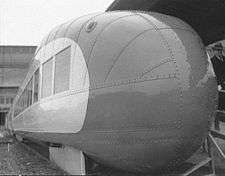M-10000


The Union Pacific Railroad's M-10000, delivered to the railroad on February 12, 1934, at a cost of $230,997, was the first internal combustion engine, lightweight streamlined express passenger train built in the United States.[1] The M-10000 featured a turret cab, an inward-slanting Duralumin body with a nose formed of parabolic arches, and large nose air intakes on each side of the centerline. The prime mover was a 600 hp (450 kW) Winton 191-A V12 distillate engine. This engine design was unrelated to the later 201 or 201A Winton diesels. There were three cars: a driving, power and baggage car at the front; and two passenger cars. The 204 ft (62 m) long, 85-short-ton (77 t) train was fully articulated, with trucks shared between cars. The front truck carried one General Electric traction motor per axle, and was the only one powered. The train was painted in Armour Yellow with Leaf Brown roof and undersides. Later, the area around the front air intake was also painted yellow. Dividing lines of red separated the colors.
The sleeping car "Overland Trail" was constructed for M-10000 and included in the consist during its February - May 1934 publicity tour, but it was never used in regular service with that train; instead, because of M-10000's assignment as a day train the sleeper was mated with the next Streamliner, M-10001.
Development
The M-10000 car design built upon the efforts of William Bushnell Stout, a pioneer of all-metal construction for airplanes who adapted metal fuselage design to the Railplane (not to be confused with the Bennie Railplane), a lightweight self-propelled railcar built by Pullman-Standard in 1932. The tapered car cross-section, lightweight tubular aluminum space frame construction, and Duralumin skin of the Railplane were carried over into the M-10000 design.[2] Pullman engineer Martin P. Blomberg helped style the exterior of the M-10000 and the M-10001.
The US Patent and Trademark Office assigned U.S. Patent D100,000, U.S. Patent D100,001, and U.S. Patent D100,002 for the design. The locomotive and railcar bodies, and interior fittings, were built by Pullman-Standard. The Electro-Motive Company (EMC) developed the electric propulsion system driven by the Winton engine. As was their practice as a system engineering firm at the time, they contracted manufacture of the components of their systems to primary equipment manufacturers. General Motors' Cleveland subsidiary, the Winton Engine Company, provided the prime mover. The air brake compressor, main generator, traction motors and control equipment were manufactured by the General Electric Company. Skepticism that development efforts for Diesel motors underway in the early 1930s would yield to timely release of an engine adequate for high speed rail service led to use of a spark-ignition distillate engine. Trucks were strongly influenced by German passenger bogie design, as investigated by Union Pacific chief engineer A.H. Fetters.
Service life
The M-10000 entered daily revenue service between Kansas City, MO and Salina, KS as The Streamliner on January 31, 1935. It was subsequently named City of Salina as Union Pacific adopted the "City of..." convention for its new streamliners, but also was also nicknamed the "Tin Worm" or "Little Zip". In 1941, after 995,000 miles of service, the train's limited fixed capacity and the dated technology of its distillate engine had rendered it obsolete and it was retired. Since it was built of Duralumin (aircraft aluminium), the M-10000 was scrapped in early 1942 to contribute its materials to the war effort.
Historical significance
While M-10000 faced early obsolescence leading to its short service life, its exhibition tour starting in February 1934 followed by its presentation at the 1934 Century of Progress Exposition captured the imagination of Depression-era America as to what the future of rail travel could be. During its 13,000-mile (21,000 km) exhibition tour across the US, it visited Washington DC for inspection by Franklin Delano Roosevelt. Everywhere it went, the train then named "The Streamliner" attracted crowds and press attention, hosting over one million visitors.
In contemporary memory M-10000 has long since been eclipsed by the Pioneer Zephyr, but the M-10000 was the first streamliner on the rails and the first streamliner media sensation. Diesel-powered trainsets built for Union Pacific in 1935 and 1936 were evolved from the M-10000 design. The paint scheme devised for the M-10000 became the trademark color scheme for Union Pacific streamliners, incrementally modified to Union Pacific's current scheme with Harbor Mist Gray.
See also
References
External links
| Wikimedia Commons has media related to M-10000. |
- "The Iron Horse Goes Modern" Popular Mechanics, September 1933 -- detailed article on Union Pacific engineering research that lead to the M-10000
- "Tuning Up A Streamliner" Popular Mechanics, November 1935 pp. 718-719 improvements resulting in the M-10001
- Winchester, Clarence, ed. (1936), "The Union Pacific Streamlined Express", Railway Wonders of the World, pp. 33–39, contemporary description of the train